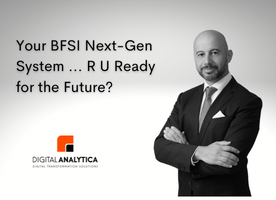
This is custom heading element
When it comes to BFSI (Banks & Insurance) CORE systems, is your system ready to sustain your future aspirations? What about new innovative ideas, how fast can you incorporate and adapt to such capabilities into your current system?
Or, are you going to wait on the curbside until all other banks get ahead of your organization’s core capabilities? I think if you wait then it’s going to be too late!
The other day, I had an interesting discussion about this topic with a bank executive and based on our discussion I believe we concluded with 5 main aspects to consider when evaluating your CORE system. These five items go as follow: 1- Technology 2- Business verticals (in general) 3- Business vertical capabilities 4- Future innovations & sustainability 5- Implementation & ownership cost

In this article, I meant not to mention the CORE integration bus or, but the CORE system itself. Since I believe that such a topic requires a full in-depth article to discuss such technology.
So, the first item to discuss is Technology vertical :

The technology aspect is the main driving aspect of the CORE system, and it’s very important to check its overall tiers and technology layers to ensure its capabilities to integrate and deliver what’s intended to do.
For example, you might need to understand how the system is integrating and interacting between all tiers. For instance, in one of my previous engagements, the CORE system fully interacted with the backend dBase via stored procedures, making the system totally unpredictable and heavy on the dBase side. Moreover, the dBase (Even though it was relational dBase), but the application was dealing with the dBase as if it’s an un-relational type of dBase, making the system semi-impossible to maintain! So, when things were changed in one part of the application, other items were changed as well, but without us being able to assess!
Another example: In the EMEA region we notice that many CORE systems were designed and developed via FORMS & REPORTS! Well, this was good practice 20 years ago, but not today. Such technology is extensively heavy on the dBase which will require mighty hardware systems to sustain their activities, let alone their security pitfalls, and the inability to get on the spot insights!
But for a Next-Gen CORE system; such systems needs to ensure that it has the following capabilities: Exposed APIs with a specific standard for all calls (plus, an API dictionary), Agnostic Cloud hosting, Blockchain integration, Integration capabilities with internal systems (including an internal bus integration), An API Gateway, Modules based, Omni-Channels capabilities, Support for Micro-services, Security and Compliance to the international standards (such as AML / PEP or Data related such as GDPR & PCI-DSS), Scalability and Last but not least Customizable UX (User Experience).
The next items are Business, Retail, FX, Derivates, and Corporate verticals:

This part has to do with the business’s overall aspiration for certain verticals, such as (but not limited to): Retail, Corporate, Wealth Management, Wholesale & Syndicates, and Retail insurance, and Wholesale insurance.
The next item is Future Innovations and Sustainability vertical: This is one of the most critical vertical when it comes to fulfilling the aspirations of the future business initiatives, and connecting with FinTechs could be the best way to expedite the path into innovation and new capabilities. In this case, the API gateway will play a master role in moving the bank or insurance in this direction. In fact, the API gateway can move your CORE System into a next level, and even replace some of the old banking business procedures to be conducted via API calls.
Some CORE systems will even have pre-qualified Fin-techs (an open marketplace) to choose Fin-Tech capability and integrate with it. This is a game changer for any legacy CORE system, plus it will enhance the Bank’s overall capabilities and catch up with the global technology changes and bank’s aspirations.
Here are some examples of such CORE systems: Mambu, Temenos, Intelect and many others … Which Core system do you like the most, and why? Or do you rather move forward without a CORE System (AKA the GL approach)? Drop a line please.


